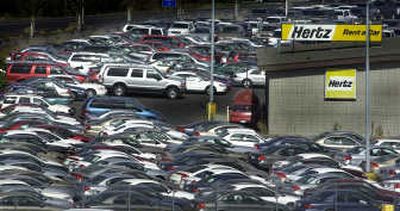Rent a wreck? Not quite

Michael Klatt misses the days when rental cars were shiny and new.
In June, he rented a Ford Taurus in Fort Lauderdale, Fla., that had loose steering and stained seats. “I was literally touching it to see if it was wet,” he said . The car, which had 20,000 miles on it, also had brakes that were a little wonky — he had to push down hard on the pedal to make them work.
“Before you didn’t get a car with 20,000 to 25,000 miles,” the New Hill, N.C., resident and longtime Hertz customer said . “You can tell: They ride rough; they have a shimmy going down the road; the seats have stains on them. It’s like rent-a-wreck.”
Paula Rivera, a Hertz spokeswoman, said the company’s fleet age — typically 8 to 12 months and 16,000 to 20,000 miles — hasn’t changed, and that its cars are maintained in accordance with manufacturer guidelines.
But while customers and car-rental companies debate whether the quality of rental cars is sliding, the rental companies are indeed implementing stingier policies as they look to cut costs. Vanguard Car Rental, which operates National Car Rental and Alamo Rent A Car, says that there are about 2,000 more miles on its vehicles on average fleet-wide now compared with a year ago. Hertz is being less generous with its loyalty program and after-hours drop-offs. And some customers say rental-car companies are being more nitpicky about where they refuel, with some renters being slapped with fuel fees if they fill up more than a few miles from the airport.
Rental-car companies have been pinched because auto makers, desperate to get their own finances under control, are curtailing the practice of selling less-profitable “program” cars to fleets. Program cars are vehicles that rental companies buy at a reduced cost, then resell at prearranged prices through auction lots, usually after around nine months. The auto makers used that avenue to rid themselves of excess production. So rental companies are now filling their fleets with a larger share of “risk” cars — cars they ultimately have to sell themselves, possibly at a loss.
Companies say that consumers shouldn’t notice a difference in their rental cars — even if they have more mileage. Vanguard, which Enterprise Rent-A-Car Co. recently bought, says the additional 2,000 miles on its cars is nothing dramatic. Also, the cars are maintained by manufacturer-certified mechanics and generally disposed of before they reach 20,000 miles. Industry observers agree. “The cars are maintained fairly well,” said Chris Brown, managing editor of the trade publication Auto Rental News.
Higher gasoline prices may also be spurring some companies to be a bit more stringent about refueling. Before Jason Smith returned his rental car at Chicago’s O’Hare International Airport in August, he filled up at a gas station 15 miles away. It never occurred to him he might be charged for having less than a full tank. But the needle had nudged just below “F.” The attendant at the National Car Rental site charged him for an eighth of a tank, Smith said , which works out to nearly $17. “I showed them the receipt, but they were like, ‘Sorry, you’ll have to take that up with corporate,”’ he said .
National stands by that decision. “We’re not giving away gasoline,” said Charles Pulley, a spokesman for Vanguard.
It’s clear that rental companies have to be careful about gas. Because gas prices are high and profit margins on rentals are slim — the typical margin on a $50 rental is around $5, which is not much more than the price of a gallon of gas — companies need to be stingy, industry experts say. “This is an area where profits can literally leak out of the fuel tank,” said Neil Abrams, president of Abrams Consulting Group Inc., a car rental consultancy.
Dollar Thrifty Automotive Group Inc. says its policy is that renters need to fill up within 10 miles of the return location and be prepared to show their receipt. If they don’t, they can be charged for refueling, which generally includes a per-gallon charge and a service fee. Enterprise, Hertz and Avis Budget Group Inc. say they do not mandate where renters refuel. Vanguard says so as well, but Steve Clark, who rented a car from Alamo in Orlando in April, said he was told by the rental agent that he had to refuel within a three-mile radius of the return site.
Consumers who pre-pay for their gas with the rental company usually have to pay about a quarter more than the typical price at the pump. But those who waive that option can be charged $5 to $7 a gallon, if the company says the tank isn’t full enough.
The problem with having to refuel so near the return site, consumers say, is that some gas stations use their proximity to rental-car drop-off areas as an excuse to gouge customers. “That does go on,” said Geoff Sundstrom, a spokesman for AAA, the automobile association. Jason Smith, the National renter, said that’s why he filled up 15 miles away from O’Hare.
Despite the nickel-and-diming, industry observers say car rentals are still a decent deal compared with the rest of the travel industry. The rental companies have hardly engendered the disgust that the airlines did this summer with their record delays, and though the cost of a rental is rising, the increase isn’t greater than that of other travel industries. Abrams said that rates are up between 5 percent and 7 percent for the year.